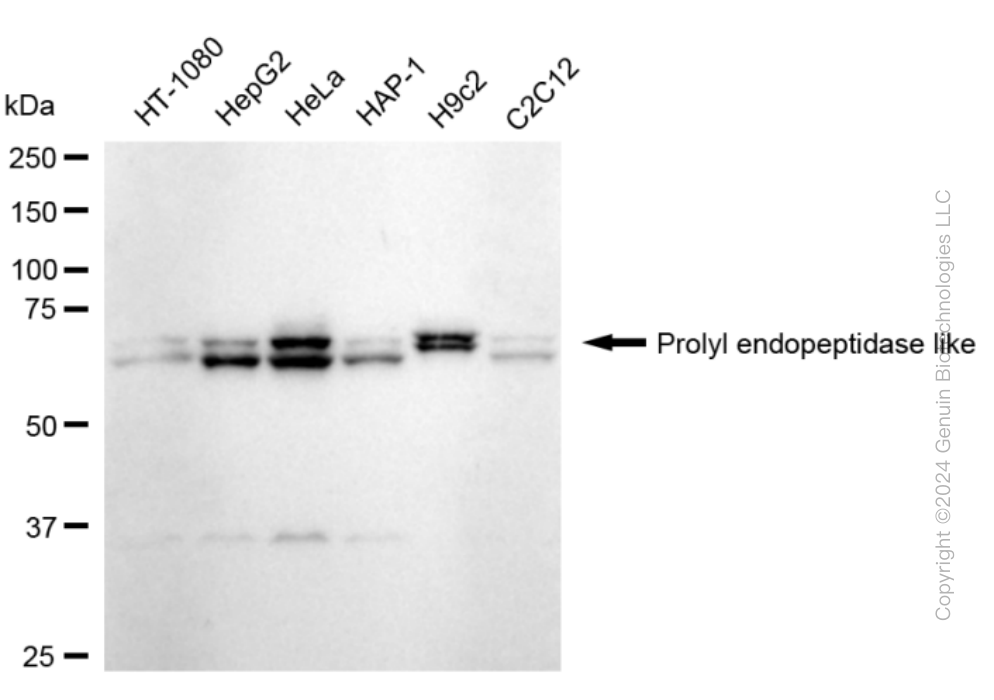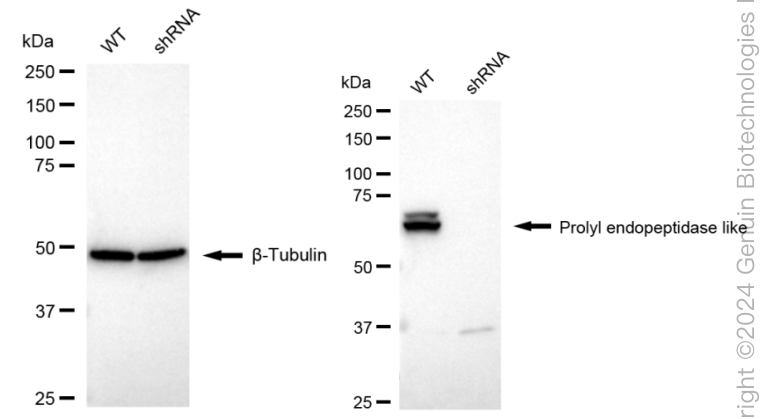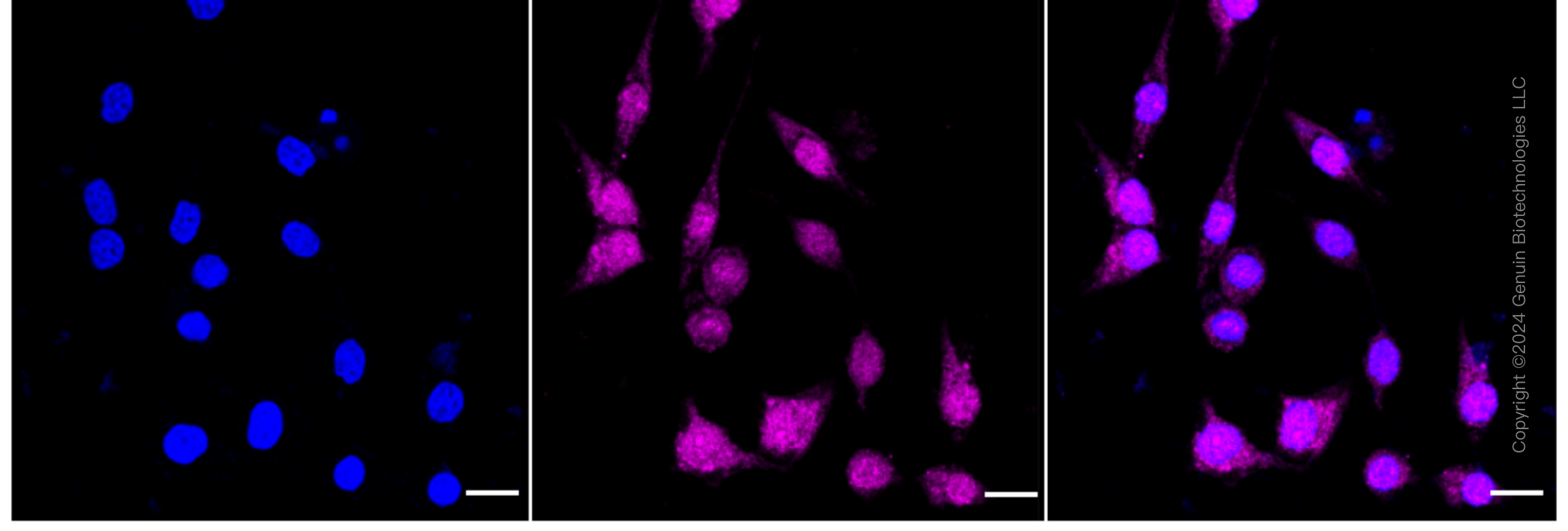KD-Validated Anti-Prolyl Endopeptidase Like Rabbit Monoclonal Antibody
Rabbit monoclonal antibody
- SPECIFICATION
- CITATIONS
- PROTOCOLS
- BACKGROUND

Application
| WB, FC, ICC |
|---|---|
| Primary Accession | Q4J6C6 |
| Reactivity | Rat, Human, Mouse |
| Clonality | Monoclonal |
| Isotype | Rabbit IgG |
| Clone Names | 24GB990 |
| Calculated MW | Predicted, 84 kDa , observed , 70 kDa |
| Gene Name | PREPL |
| Aliases | Prolyl Endopeptidase Like; Prolyl Endopeptidase-Like; KIAA0436; Putative Prolyl Oligopeptidase; Prolylendopeptidase-Like; EC 3.4.21.83; EC 3.4.21.-; EC 3.4.21; CMS22 |
| Immunogen | A synthesized peptide derived from human PREPL |
| Gene ID | 9581 |
|---|---|
| Other Names | Prolyl endopeptidase-like, 3.4.21.-, Prolylendopeptidase-like, PREPL, KIAA0436 |
| Name | PREPL |
|---|---|
| Synonyms | KIAA0436 |
| Function | Serine peptidase whose precise substrate specificity remains unclear (PubMed:16143824, PubMed:16385448, PubMed:28726805). Does not cleave peptides after a arginine or lysine residue (PubMed:16143824). Regulates trans-Golgi network morphology and sorting by regulating the membrane binding of the AP-1 complex (PubMed:23321636). May play a role in the regulation of synaptic vesicle exocytosis (PubMed:24610330). |
| Cellular Location | Cytoplasm, cytosol. Golgi apparatus, trans-Golgi network {ECO:0000250|UniProtKB:Q8C167}. Cytoplasm, cytoskeleton {ECO:0000250|UniProtKB:Q8C167}. Golgi apparatus {ECO:0000250|UniProtKB:Q8C167}. Nucleus Note=Co-localizes with AP-1 in the trans-Golgi network (By similarity) Co-localizes with MAP2 and ACTB on the cytoskeleton (By similarity) Co-localizes with STX6 and GOSR2 at the Golgi apparatus (By similarity). {ECO:0000250|UniProtKB:Q8C167} |
| Tissue Location | Expressed in pyramidal neurons of the temporal cortex and neocortex (at protein level) (PubMed:23485813). Widely expressed (PubMed:15913950, PubMed:16385448). Expressed at higher level in brain, skeletal muscle, heart and kidney (PubMed:15913950, PubMed:16385448). Expressed at the endplates in the neuromuscular junction (PubMed:24610330). |

Thousands of laboratories across the world have published research that depended on the performance of antibodies from Abcepta to advance their research. Check out links to articles that cite our products in major peer-reviewed journals, organized by research category.
info@abcepta.com, and receive a free "I Love Antibodies" mug.
Provided below are standard protocols that you may find useful for product applications.
If you have used an Abcepta product and would like to share how it has performed, please click on the "Submit Review" button and provide the requested information. Our staff will examine and post your review and contact you if needed.
If you have any additional inquiries please email technical services at tech@abcepta.com.














 Foundational characteristics of cancer include proliferation, angiogenesis, migration, evasion of apoptosis, and cellular immortality. Find key markers for these cellular processes and antibodies to detect them.
Foundational characteristics of cancer include proliferation, angiogenesis, migration, evasion of apoptosis, and cellular immortality. Find key markers for these cellular processes and antibodies to detect them. The SUMOplot™ Analysis Program predicts and scores sumoylation sites in your protein. SUMOylation is a post-translational modification involved in various cellular processes, such as nuclear-cytosolic transport, transcriptional regulation, apoptosis, protein stability, response to stress, and progression through the cell cycle.
The SUMOplot™ Analysis Program predicts and scores sumoylation sites in your protein. SUMOylation is a post-translational modification involved in various cellular processes, such as nuclear-cytosolic transport, transcriptional regulation, apoptosis, protein stability, response to stress, and progression through the cell cycle. The Autophagy Receptor Motif Plotter predicts and scores autophagy receptor binding sites in your protein. Identifying proteins connected to this pathway is critical to understanding the role of autophagy in physiological as well as pathological processes such as development, differentiation, neurodegenerative diseases, stress, infection, and cancer.
The Autophagy Receptor Motif Plotter predicts and scores autophagy receptor binding sites in your protein. Identifying proteins connected to this pathway is critical to understanding the role of autophagy in physiological as well as pathological processes such as development, differentiation, neurodegenerative diseases, stress, infection, and cancer.





